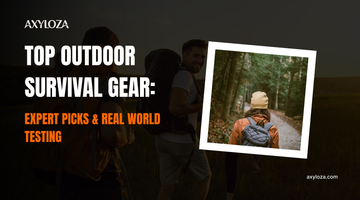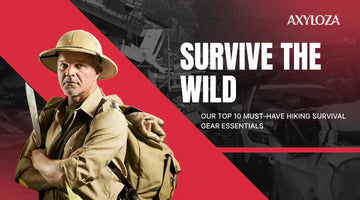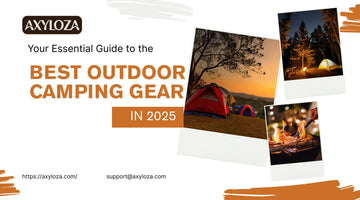If you're planning a trek, an overnight in the wild, or just preparing for the unexpected, having the right outdoor survival gear can mean the difference between comfort and crisis.
This guide breaks down what experts actually recommend, what tools perform under pressure, and how to build a survival gear list that works.
Gear Survival Experts
Experts who test gear in extreme conditions often come back with the same essentials. Whether you're talking urban survival gear, camp survival gear, or gear for off‑grid wilderness, certain items repeatedly prove themselves.
According to multiple field‑tested guides, essential tools include fire starters, water purification systems, a solid knife or multi‑tool, navigation equipment like a map & compass, emergency shelter, first aid supplies, lighting, and cordage.
Why these tools make every survival gear kit:
- Fire starters give you warmth, the ability to cook, and a signal in emergencies.
- Water filtration or purification ensures you can stay hydrated safely.
- Navigation tools prevent you from getting lost or help you get found.
How to Choose the Right Outdoor Survival Gear?

Not all survival gear is built the same. Picking the right gear tools for your environment, skill level, and adventure type matters.
- Environment & climate: High altitudes, desert, jungle, or arctic all demand different gear. What works in the woods may fail out at sea.
- Weight vs durability trade‑off: Bulky gear may be more durable, but heaviness kills stamina. Light backpacking gear is great if it still holds up under stress.
- Function over feature‑leadenness: Simple tools often perform better in emergencies. For example, a good fixed‑blade knife often beats a gadget with many parts that can fail.
-
Tested performance: Gear that’s been tested in real situations, wilderness, storms, wear‑and‑tear, tends to outperform gear with flashy marketing.
Build your kit around essential survival gear first, then add “nice to haves” like adventure motorcycle gear or climbing gear as needed.
Essential Outdoor Survival Gear
Here are the core components of a survival gear list that hold up in real conditions. These are must‑haves in any serious survival gear and equipment setup.
Core Items Checklist
|
Item |
Purpose / Why It Matters |
|
Fixed‑blade knife or multi‑tool |
Cutting, shelter building, food prep, and first aid tasks. |
|
Fire starter (ferro rod, waterproof matches) |
Fire = warmth, cooking, dry clothes, signaling. |
|
Water filter/purification tablets |
Clean water is non‑negotiable. |
|
Emergency shelter (tarps, bivy sack, emergency blanket) |
Protection from elements. |
|
First aid kit with essential supplies |
Immediate response to injuries. |
|
Navigation gear (map, compass, GPS backup) |
Helps you stay on track or find your way out. |
|
Headlamp/flashlight with spare batteries |
Illumination & signalling at night. |
|
Cordage (paracord, rope) |
Shelters, gear repair, and fastening. |
|
Signalling tools (whistle, mirror) |
For rescue situations. |
|
Warm clothing & rain gear |
Insulation & protection from weather. |
These items are part of most recommended survival‑gear lists.
Survival Gear Kits vs Specialized Gear
Having a survival gear kit is great, but in many cases, you’ll need specialty tools depending on your activity. Here are comparisons.
- Survival gear kit: general purpose, built for portability and covering basics (shelter, water, fire, health). It’s what you throw in your pack for hiking, emergency prep, car kits.
- Outdoor Climbing Gear: It includes climbing harness, ropes, carabiners, belay device, etc., gear specific to vertical terrain and safety during ascent/descent.
-
Adventure motorcycle gear/adventure riding gear: armored jackets, rugged backpacks, protective boots, and visibility enhancements. It adds protection, not just survival.
If you combine general survival gear with specialized tools for your adventure, you get a kit that’s both versatile and safe.
What Makes the Best Survival Gear Brands?
When you’re investing in the best outdoor gear brands, these are qualities to look for:
- Proven durability in harsh conditions.
- Good warranty & repair service
- Universal compatibility among tools (“modular” designs)
- Lightweight materials without sacrificing toughness
-
Excellent customer feedback from people who’ve tested gear “in the wild”
Well-regarded brands often focus on quality control, real‑world field testing, and incremental improvements based on user feedback.
Product Details
Here are some benefits & specs you’ll want in top‑tier outdoor survival gear:
- Built with weather-resistant, durable materials (e.g., waterproof fabrics, rust‑proof metals)
- Compact and lightweight design for portability without compromising function
- Multi‑functional tools that reduce the number of separate items needed
- Reliable shelter options—either permanent (tents) or emergency (tarps, bivy)
- Effective water purification capability (filters, UV, tablets)
Packing Your Outdoor Survival Gear Backpack

Once you’ve chosen what gear you need, how you pack it matters just as much.
- Distribute weight intelligently (heavy items close to the back and centered)
- Keep frequently‑used gear (knife, flashlight, map) easily accessible
- Use compartments or roll‑top dry bags inside the pack to protect gear from moisture
-
Keep signalling tools and first aid external or top‑layer for quick reach
Need quality packs that can handle rugged terrain? Explore backpacks & survival pack offerings made to survive.
Pro Tips for Maintaining Your Survival Gear
Buying gear is only part of the job. Maintenance ensures it works when you need it most.
- Regularly test the fire starter, water filter, and batteries before traveling
- Dry and clean gear after use to prevent mildew, rust, and degradation
- Replace consumables (matches, cordage, emergency blankets) periodically
- Practice with your tools, knives, shelter setups, and navigation, so you know how they work under stress
Real‑World Tested Survival Gear in 2025
What are people taking into the field right now? These are tools that have proven themselves in recent trips and emergencies:
- Multi‑tools with full tang blades and replaceable parts for sharpening
- Fire starters (ferro rods) with backup sources
- Ultralight shelters and emergency blankets that are tough yet pack small
- High-throughput water filters that clean liters quickly, even with murky water
-
LED headlamps with both high and dim modes, long battery life
These items show up year after year on survival gear list recommendations and “10 essentials” style lists.
Conclusion
Building a solid outdoor survival gear setup isn't just about owning the flashiest gear; it’s about reliability, versatility, and tools that perform when everything else fails. Whether you're assembling a survival gear kit for emergencies, adventure climbing gear for alpine treks, or camping and survival gear for long backcountry trips, these essentials form your foundation.
Don’t wait until you need gear to realize what’s missing. Start with the core gear, upgrade thoughtfully, maintain your tools, and practice using them. Because when you're out there, having trustworthy gear and knowing how to use it can make all the difference.
If you’re ready to gear up, check out the latest rugged backpacks, survival kits, and equipment at Axyloza’s survival gear selections. Equip yourself with gear that’s ready for anything.
FAQs
Q: What is the best survival gear for outdoor emergencies?
The best outdoor survival gear usually includes a durable knife or multi‑tool, a reliable fire starter, effective water purification, an emergency shelter, navigation tools, a first aid kit, lighting, and signalling tools.
Q: Which survival tools have been tested in real‑world conditions?
Tools like ferro rods, fixed‑blade knives, waterproof tarps, quality water filters, LED headlamps, and sturdy backpacks are repeatedly validated in real expeditions.
Q: How to choose the right survival gear for my environment?
Consider climate (rain, cold, heat), terrain (mountains, forest, urban), duration of trip, and how remote you’ll be. Urban survival gear vs wilderness survival gear will differ: urban kits may prioritize defense, signal tools, and lightweight compactness; wilderness kits need shelter, water, and fire for longer durations.
Q: What gear do survival experts carry in their kits?
Field‑tested kits often contain: multi‑tools, emergency shelter, ample cordage, high-quality water purification, navigation (map + compass, possibly GPS), fire starters, headlamps, first aid, signalling devices (whistle, mirror), and layers of clothing for varying conditions.
Q: What’s the difference between cheap survival gear and expert‑recommended gear?
Cheap gear often sacrifices material quality (thin metals, weak seams, poor waterproofing), testing, or fails under stress. Expert gear might cost more, but it is tested for durability, reliability, weight, and ease of use. It often includes warranties or spare parts.



